Alec Soth in conversation with Doug DuBois
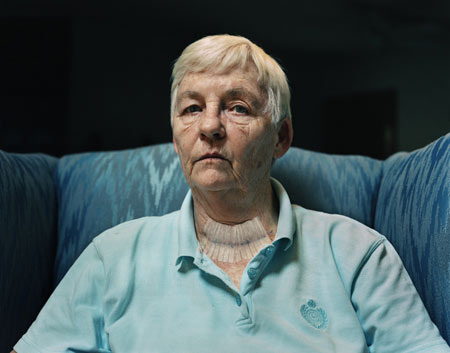
A little while ago, Alec Soth got in touch with Doug DuBois to talk about his work. As is sometimes the case with interviews, things took their time. When the piece was finished, past the point where Alec had decided about his blog’s hiatus, he approached me and asked whether I was interested in posting the interview on Conscientious, along with his introduction and the images showcasing Doug’s work. Of course, I was. Find everything below. My thanks to Alec and Doug for sharing! - Jörg Colberg
(Alec Soth:) The most influential exhibition during my college years was Pleasures and Terrors of Domestic Comfort (MoMA, 1991). The show made domestic life seem like a worthwhile subject for photographers. Especially exciting was that the show introduced me to a bunch of new photographers. Until then I’d never heard of Gregory Crewdson or Philip-Lorca DiCorcia. But the greatest discovery, and the star of the show, was Doug DuBois. More than anyone else, his family pictures lived up to the thrilling title of the show.
Since then I’ve only encountered Dubois’ pictures a few time. I have an old issue of DoubleTake with his pictures of Avella, PA. And I have a catalog for a show called Close to Home. In his statement for that show, Dubois writes the following:
In the spring of 1985, my father fell from a commuter train. On a late night express, he walked between two cars and was found six hours later lying between the east- and westbound tracks. It took him a year to recover and walk on his own againMy father’s daily care fell upon my mother, along with her responsibility for my brother, the house and the pile of medical bills. One New Years Eve, my mother would suffer a nervous breakdown and be hospitalized for a month. I sat at the table and made a photograph, but I did not recognize my mother’s illness. I remained outside her grief and saw only the space that separated my parents.
In my most intimate photographs there is a detachment that speaks of my isolation. I no longer see my family as an assured source of comfort but as a part of the confusion of my adult life. In the conflict between intimacy and detachment, I feel the loss of my childhood family.
Since those early encounters with his words and pictures, I’ve been a fan of Doug DuBois…a frustrated fan. DuBois has to be at the top of the list of under-appreciated American photographers.
Doug DuBois has a good website. (Does this guy take a bad picture?). But there isn’t much other information about him online. So I emailed Doug and he graciously agreed to an interview.
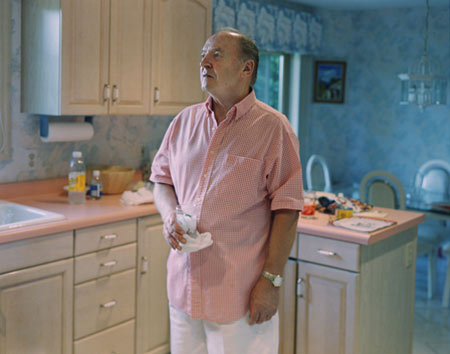
Soth: Let’s go back to the Pleasures and Terrors exhibition at MoMA. How old were you when you participated in this show?
DuBois: Pleasures and Terrors occurred a few years after I got my MFA from the San Francisco Art Institute. I began photographing my family a year or so out of college (I did my undergrad at Hampshire College where I worked with Jerry Liebling - a terrific photographer and influential educator now in his 80’s and Abraham Ravett who is primarily a filmmaker who at the time was doing work on his family - he was and remains an important influence on my work and thinking about art.) The work began quite casually. Originally the photographs had writing under them a la Jim Goldberg (another important influence and mentor) and I used the work to apply to grad school.
A few months before I was to move to California for grad school, my father fell from a commuter train. I spent the summer at home helping out with is recovery and began photographing in earnest. I brought all of this work to California. Larry Sultan was teaching at the Art Institute then, but I had no idea he was photographing his family. His advice and guidance on my work was critical. I was lucky to have some good teachers.
If I remember correctly, the exhibition itself received very mixed reviews when it opened. I was too shy to talk with anyone at the opening and Mitch Epstein (I was his printer at the time) very generously threw me a little party afterward. A bunch of Yale MFA students came - none of whom I knew— and a few of them trashed the exhibition with typical grad student bravado. In the end I think the exhibition was smarter than its critics. Besides articulating and defining something akin to a domestic genre in photography, it was a very early attempt to reconcile, so to speak, postmodernist tactics and strategies with modernist/realist work. A similar curatorial approach is echoed in the Tate Modern’s exhibition Cruel and Tender.

Soth: How did your family feel about getting so much attention?
DuBois: I think there was a great deal of excitement and my parents were very happy and proud to see my photographs and their images in the museum. In the beginning, I think my parents thought the family photographs were a bit of a fluke and I would soon turn my attentions elsewhere. My sister, Lise, always had a fairly sophisticated understanding of the project. She sat in on a critique when I was in grad school and a fellow student asked her more or less the same question - how she felt about her photographs. She answered that she recognized the images as a somewhat fictional and subjective view of her and our family. She trusted this fiction and my subjectivity, not so much for its accuracy but (I think) for my discretion.
That trust is critical to the work but I have to admit that I have tested it from time to time. The most difficult moment came in 1999 when I published a series of photographs in the Lives page of the New York Times Magazine. The article contained an interview with my sister and mother about their respective divorces along with two photographs of each of them. My motivations for doing the article were complex and not necessarily healthy or honest. My father, who was never named in the article, had to field all sorts of calls from family and friends who knew nothing of the divorce and couldn’t understand why it was in the New York Times Magazine. For the first (and only time) my father accused me of exploitation and in this case, at least, he wasn’t too far off the mark. I wasn’t sure that my father would let me photograph him again - but we managed to reconcile and my father is a frequent visitor to my website and very generous with my efforts to photograph him.
Soth: From what I can tell from your website, you stopped working on the family pictures the year following the MoMA show. Why did you stop? And why did you start again in the 1999?
DuBois: My parents and brother moved to London and I moved to New Mexico to teach. We hardly saw each other for most of the 1990’s. Trying to make photographs during those brief visits wasn’t terribly productive or good for our relationship. I spent most of that time photographing in Avella, PA where my grandmother raised her family and my grandfather worked in the coal mines. I was still interested in family and narrative - my grandmother’s stories inspired and fueled the project - but the work was far less hermetic and insular.
It wasn’t, however, a very conscious decision - the family work just petered out in a frustrated, anxious way. I never resolved or came to terms with what the project meant to my idea of photography or myself as an artist.
In 1999, I moved back to the east coast and my parents had returned to New Jersey. But I wouldn’t say it was simply geography that got me started again. I was really thinking about what it meant to make photographic portraits, what the encounter between the photographer and subject can mean or, more precisely, how it shapes the image. I was doing a bunch of small projects like making portraits of Vespa riders at stoplights, adolescents in marching bands, etc. Each of the series formed a kind of typology but in the end I was fascinated by the interruption itself: the tension, however slight, that registers on the face and body, the silent negotiation between photographer and subject. The regrettable analogy that pops into my head is two dogs sniffing each other - tentative but intimate.
With my family work, I took a somewhat opposite tack to achieve a similar tension. The photographs became more constructed, more formally engaged and less invested in capturing a moment or gesture as it unfolds The process of making one photograph sometimes extends to two or three shooting sessions, I use film stills for inspiration and explicitly reference earlier photographs. But I am still looking for a visual, almost palpable tension in the photographs to initiate an emotional or narrative cue. It sounds a bit manipulative, but I am pretty upfront with my family about what I’m trying to do in any given photograph, this tension (awkwardness, frisson — it’s hard to define) is as much a formal device as an emotional effect (affect?). I guess what I’m trying to say is that involves more collaboration than manipulation.

Soth: Having worked on this project for so long, we get the feeling of an extremely intimate family album. We get to watch Luke and Lise grow up. We even see a child whom, I assume, belongs to Lise. But your presence is always a bit mysterious. You say that “In my most intimate photographs there is a detachment that speaks of my isolation.” Can you elaborate on that? Where are you in these pictures?
DuBois: I wrote that quite a long time ago when I was in my late twenties. It still rings true to me, but the context has changed considerably. At the time, I was just beginning to realize in a very profound way that my family, especially my parents, were quite separate from my own needs and expectations. Their issues, desires, frustrations and emotional history were distinct from mine and while approachable and comprehensible (in some important ways, explicitly visible) would always and forever remain elusive and at a distance.
I realize I sound like a sentimental existentialist, but I feel this dilemma informs all intimate relationships - familial or otherwise. I don’t think photography can bridge that gap, but it can certainly picture it, render it more, or less scary, and give it a form for contemplation and a longing that life, perhaps, might be otherwise.
So where am I in the pictures? — literally and figuratively behind the camera. But the gaze that stares out at you from the photograph — that gaze is directed (literally and figuratively) at me. Despite the illusion of transparency, I am always between you and the picture.
I hope that makes some sense.
As far as my own personal life — I’m married to a brilliant filmmaker and have no kids. But I’m a cool uncle and I think my sister and I are very close. I do have another sister, Beth, and very early on, when I first began these photographs, she asked not to be part of the work. I respect her decision and we are both quite comfortable with the arrangement. She’s a very dedicated minister and she officiated my wedding.

Soth: Did you edit out these pictures or altogether refrain from photographing Beth. Maybe she’ll change her mind in twenty years.
DuBois: I more or less refrained from making Beth’s photograph. Since my photographs rarely (if ever) attempt to capture a candid moment, she is never compelled to be in (or out) of the frame. If things change and I begin photographing Beth in earnest, I think she will simply appear without explanation. If it happens in twenty years, we will both as old as our parents are now - hmm, that could be interesting.
Soth: We always talk about ‘narrative photography.’ But most photographs don’t really tell stories. There is no beginning, middle and end. But more than just about any photographer I know, your pictures really do tell a story. Do you agree?
DuBois: Narrative and stories are not necessarily synonymous. I took a class in narrative theory many, many years ago and there were these terms: the suzjet and the fabula which some Russian formalist cooked up to distinguish the story from the plot. Unfortunately, I can’t remember which is which - but what is important is that there is a distinction and that any given plot can produce different stories. Individual photographs can be like little plot fragments, yanked out of large, complex stories. We can describe the plot, more or less, by looking at the photograph but we invent the story out of our own imagination and experience.
Photographs that invite narrative speculation (not all do, by any means) propel you into that imaginative story space but the best ones (for me) don’t try to tell you (specifically) what that story is. In my photographs, I try to locate the story itself outside of the frame or in the spaces between two or more photographs.
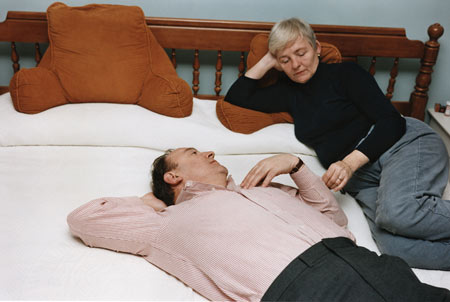
Soth: Did I read that you and Luke produced a video together?
DuBois: Yes - two, as a matter of fact. The first video was a collaboration between Jeanne Finley, John Muse and myself, titled Loss Prevention. My brother did the sound design and music. Even though I suggested him for the project, I was taken aback by the grace and beauty of his work. He has a Ph.D. in electronic music from Columbia University and you don’t need to take my word that he’s brilliant, just Google his name and read what pops up.
The video we produced together is about the death of our grandmother. It’s a three channel projection piece with a fairly complicated soundtrack comprised (mostly) of her breathing during her last days. It’s not an easy piece to install or watch and has only been exhibited a few times
Soth: What is your feeling about film making? Are you ever jealous of films like the 7Up series?
DuBois: Films are an extremely important influence - I use them quite a bit when I teach and consistently steal my best ideas from them. Not sure if I could handle their collaborative and economic demands, but, hmmm - in another life, certainly.
I recently screened excerpts from the 7up films for a class - they are terrific, but too rigorous for me be jealous of - I mean you have to produce this every seven years, it must be like training for the Olympics or running for re-election. Still, I’m always curious about what the jockey kid is up to and I’m a little less than a decade younger than each of them, so I get anxious about my own future when I watch the latest installment.
Soth: What is the current status of the project?
DuBois: Yes, I’m still shooting and Aperture will publish a book of the work in the spring of 2009. I produced a fairly complete dummy a year or so ago and have been tweaking it since. We will begin the design work next month. Exciting for me and a long time coming - but I think the timing, as far as the work itself goes, is right. It has narrative complexity and visual weight that I couldn’t have produced ten or even five years ago.
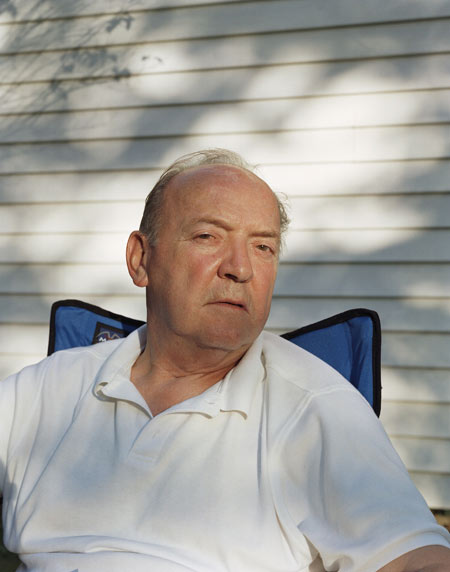
Soth: You’ve worked on the family photos for so long, I’m wondering if you ever get sick of them.
DuBois: Of course I do - and my family can only take being photographed for so long. But I keep going back and hope that their generosity holds out.
I mentioned the portrait series above and many of them are on my website - but I think I’d like to return to Avella and pull that work together into another book. I was back there a few summers ago and surprisingly enough, a lot of people remembered me. I saw some of my old photographs still tacked up around town and some people had integrated them into their family albums. Unfortunately, the town is in even worse shape than it was ten years ago - but people still hang on and try to make a life there and improve the community. I’m interested in what’s behind that blend of stubbornness, faith and inertia. It runs counter to our national ideals of self-invention and the eternal frontier, yet I think there are aspects of this predicament that are uniquely American.
Soth: You’ve also done a fair amount of editorial work. How do you mix that work into your overall practice?
DuBois: Editorial work keeps you on your toes and in shape - the unique stress and pressure of an assignment can offer up some real surprises. The hardest part is to maintain a sense of your own work and take appropriate risks in making a good photograph. You have very little time to work and no time to reflect or go at it again. Some of the best editorial work I’ve seen offer significant contributions to the photographers’ work. Larry Sultan, Mitch Epstein, Katy Grannan, etc., pull this off time and again. The frustrations come from the time limitations and other circumstances that you have to work around— and, of course, a bad edit or layout can defeat even the best efforts.
I do ok, I think. I’d like to be better. I just returned from Bali assisting Jim Goldberg on an assignment for the NYT. I don’t work as an assistant beyond helping Jim out from time to time - but I always learn something and it makes me a better photographer - plus, it can be quite an adventure.
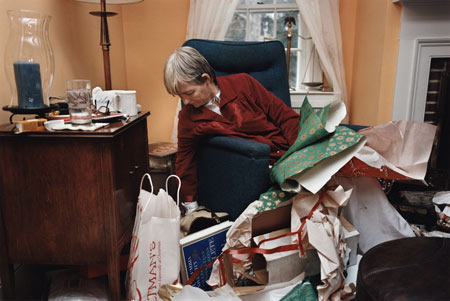
Soth: You’ve been teaching for years. Can you talk about how teaching has influenced your life as a photographer?
DuBois: I am teaching at Syracuse University in the College of Visual and Performing Arts. I’ve been there long enough to get tenure but not long enough to be too cynical (I fear, sometimes, that I am headed in that direction). I think my students are terrific and my colleagues in the photography area are great to work with. I often teach subjects, topics, techniques that I want to learn myself - I’m at my best, I think, when I’m just barely ahead of the students and not quite sure where the class is going or how to get there. It’s the only way to avoid becoming a hopeless pedantic bore. I’m amazed that I can still come home from a class all jazzed up by some idea or small pedagogical success. When done well, it’s an honorable profession - you are a positive force in someone’s life.
Soth: What are you working on right now?
DuBois: The book, which still needs a title - any suggestions? I’m eager to work with the designer and finish the edit - I have some new photographs to integrate and I still have a third or so of the reproduction prints to make. Plus writing, which is the most difficult of all. I made some new photographs in Avella. I sent a set of prints to the local, downtown bar to give out to people and promised to return this summer. I hope to make good on that promise.